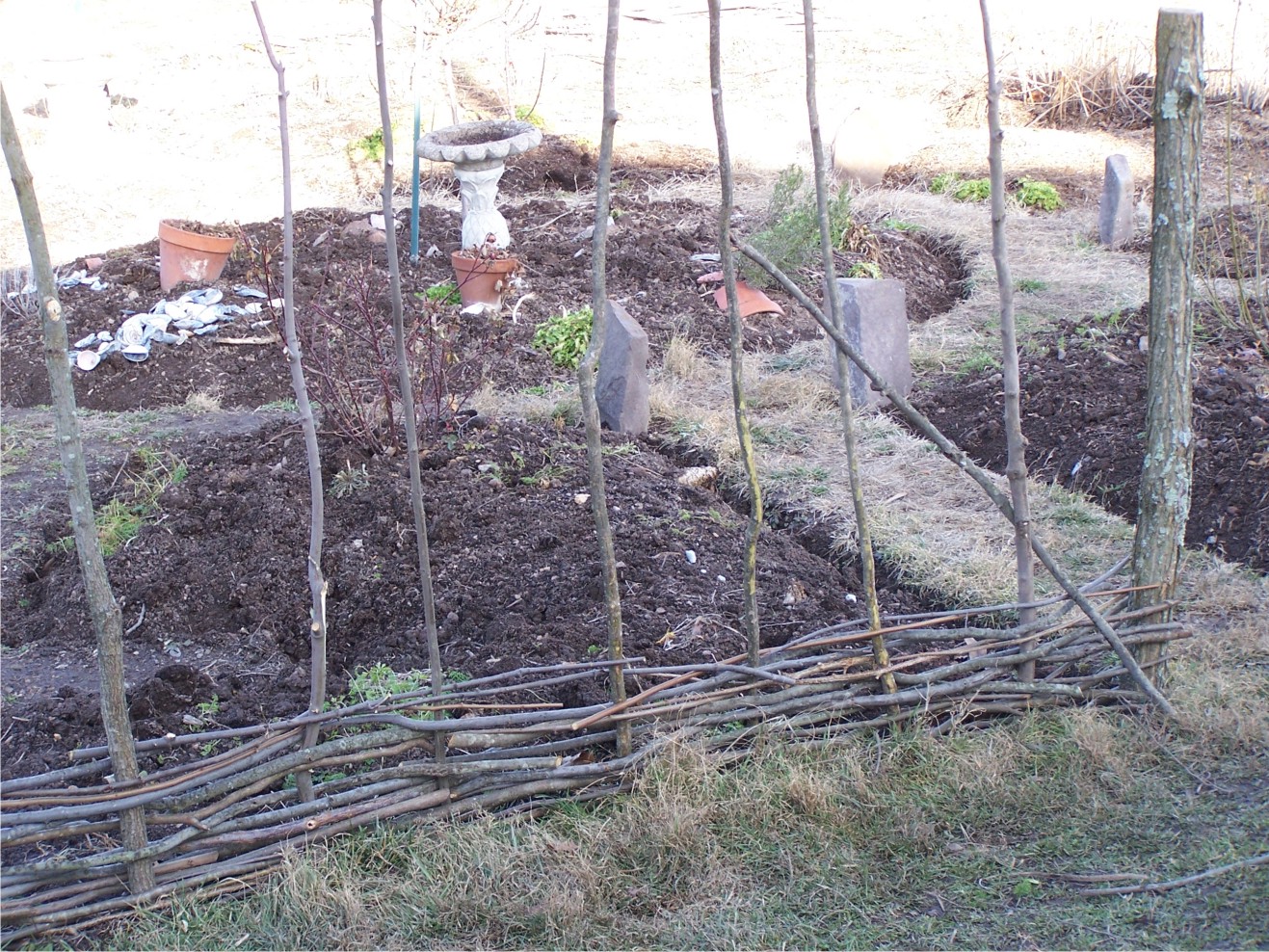Wattle Fences and Frontier Culture Museum
This weekend the weather was gorgeous. Highs in the 60’s with sunshine. It seemed a perfect time to start a project we had been discussing for some time, making a wattle fence.
Here you can see a picture of the fence that had been in place. Functional, yes, attractive, NO! However, with all the feathered friends that run around this property, it is important that we close some areas off to them, otherwise, no vegetables for us.

Our garden used to be in rows, but last year we went to permaculture inspired “key-hole” beds. The garden is divided into sections and the interior of each section is accessed by a small path called a keyhole. The garden will not be tilled, and the soil is not compacted by walking on it. It has it pros and cons. One of the benefits is that while with row gardens, fifty percent of the garden is walked on, with Key-hole gardening, about 70 percent of the garden is plantable space. The stones are my hose guides.
Back to fencing…
There were several reasons that we choose wattle fencing. By placing a more solid type of fencing on the north side of the garden, we are hoping to create a micro climate in the garden. The fence will protect the garden from the wind, and hopefully hold in more heat from the sunlight. We also chose the wattle fence because it uses available resources without us having to purchase fencing. This fence will be a great deal more work, but there is no expense involved. Another benefit is that we are thinning the saplings and branches and creating areas where the remaining trees will not have to compete as much for nutrients and sunlight.
There are actually technical terms for the parts of a wattle fence. The uprights are called “sales” and the horizontal branches are called “weavers.” The sales can be a bit sturdy, but the weavers need to be thin (less than an inch in diameter) green, (fresh woods bends more easily) and long, as long as you can find them.
Here we have started setting the sales. At each end of this section we have placed locust wood posts. Locust wood does not breakdown quickly like pine, and so these posts should be around for a while – hopefully ten years or more. Between the posts, we have placed the sales at approximately one foot intervals using a tape measure. We forced the sales into the ground using one of two methods, “drilling” holes with a cordless drill with a massive bit, or with a post hole digger. Post hole diggers can be bought at hardware stores. The sales should be firmly in the ground for the integrity of the fence.

Now we can start with the weavers. Starting at one side, gradually work a trimmed branch between the sales. Make sure that the branch extends slightly beyond the post. When the weaver is used, start with another weaver around the same sale and proceed across the row until reaching the other posts, and leave the excess there. Now return across the row you have just made, making sure that you alternate which side of the sales you are weaving through.
Historically, wattle fences were also made into “hurdles,” short eight to nine foot sections of fencing built into logs or boards about the size of railroad tracks instead of into the ground. These sections were used as moveable fencing for sheep for pasture rotation. With hurdles, the ends of the weavers were not left as we describe above, but were twisted and turned to wrap back around the post into the sales again. This makes a very durable hurdle, but in our case, we need the posts to hold our gates, and so we cannot wrap the weavers or we won’t be able to mount the gate hinges.
We have now done several rows of weaving. This is forming a strong fence – each row of weavers is making it more durable.

Here is how it stands today. It is a work in progress with a deadline. This fence must be done before the seeds are planted in the spring!
If memory serves correctly, the Frontier Culture Museum in Staunton, Virginia had a wattle fence surrounding their German homesteader garden. This living museum is a wonderful place to acquire old time skills and we recommend this place heartily! There are docents in period costume showing old world skills, and they often invite the children to participate. It is very family and children friendly, and if someone in your group cannot walk the entire tour, the Museum rents family-sized golf carts for touring the farms. Here is their website. http://www.frontiermuseum.org/index.html
In addition to touring the grounds, you can attend diverse classes and there are even homeschool events. This is one of the best and most educational opportunities in the Shenandoah region, and it is engrossing for the children as well.
Noon update: Since posting this morning, I was delighted to get this email from Alex Tillen at the Frontier Culture Museum (FCM).
“This spring the Museum once again will build a wattle fence on the Irish farm out of ash, willow, and any sapling we can find on the wooded areas of the Museum. This time we are going to use locust saplings as the post to see if they will last longer then a few years. We also plan to make some wattle hurdle fence sections on the Irish farm.”
He also provided these photographs of wattle fences the FCM had had in the past. Sincere thanks to the Frontier Culture Museum!


